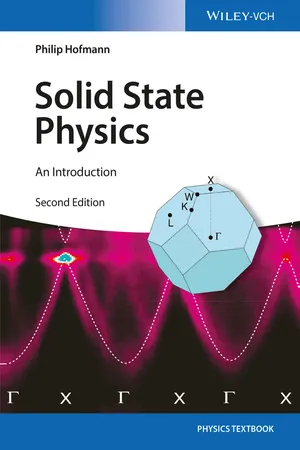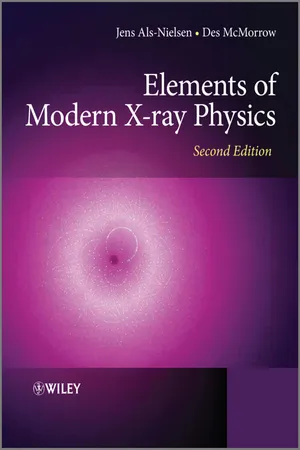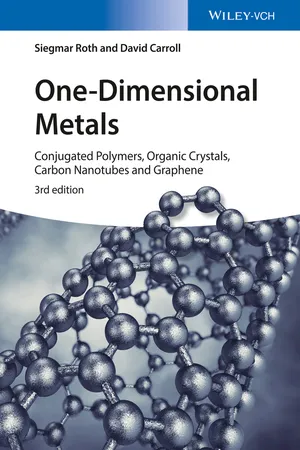Physics
Diatomic Lattices
Diatomic lattices are crystalline structures composed of two different types of atoms arranged in a repeating pattern. The atoms in these lattices form pairs, with each pair consisting of one atom from each type. This arrangement gives rise to unique mechanical and thermal properties, making diatomic lattices important in the study of materials and solid-state physics.
Written by Perlego with AI-assistance
Related key terms
Related key terms
1 of 4
Related key terms
1 of 3
8 Key excerpts on "Diatomic Lattices"
- eBook - ePub
- Timothy S Fisher(Author)
- 2013(Publication Date)
- WSPC(Publisher)
For such cases, we resort to defining the positions of multiple atoms (usually two) at each nodal site in the Bravais lattice. This approach is quite understandable for compounds such as crystalline SiO 2 (quartz), but it is also necessary to describe the lattice geometry of some monatomic crystals, including technologically important ones such as silicon and diamond. Figure 1.7 shows the crystal construction in 2D, with the multi-atom basis pair placed regularly on spatially distributed Bravais lattice points. Fig. 1.7 Structure of a two-atom basis crystal. Each nodal site of the lattice contains a two-atom basis that defines the complete crystal structure upon translation through all possible lattice vectors. One of the most fascinating 2D lattices, and one of intense contemporary study, is graphene, which consists entirely of carbon atoms in hexagonal arrangement on a 2D plane as shown in Fig. 1.8. The equilibrium distance between nearest carbon atoms is ã = 1.42 Ǻ, where the ‘ ~ ’ denotes a bond length (often the lattice constant and bond lengths differ for more complex lattices). Different edge configurations are possible in graphene, and the two most common are shown in the figure. Importantly, graphene is one of the monatomic structures that requires the addition of a basis atom to describe the full lattice. Its basis vectors, as shown in Fig. 1.9, are: The vector that connects the primary and basis atoms within a unit cell is simply Fig. 1.8 Graphene nanoribbon crystal structure. The left structure is the armchair configuration; the right structure is zigzag. Dashed rectangles represent a graphene nanoribbon unit cell. The unit cell for each configuration is displayed below the crystal lattice structure. 1.3 Mathematical Description of the Lattice The analysis of crystals can seem challenging in comparison to that of individual molecules because of the former’s vast size - eBook - ePub
Solid State Physics
An Introduction
- Philip Hofmann(Author)
- 2015(Publication Date)
- Wiley-VCH(Publisher)
This chapter is divided into three parts. In the first part, we define some basic mathematical concepts needed to describe crystals. We keep things simple and mostly use two-dimensional examples to illustrate the ideas. In the second part, we discuss common crystal structures. At this point, we do not ask why the atoms bind together in the way that they do, as this is treated in the next chapter. Finally, we go into a somewhat more detailed discussion of X-ray diffraction, the experimental technique that can be used to determine the microscopic structure of crystals. X-ray diffraction is used not only in solid state physics but also for a wide range of problems in nanotechnology and structural biology.1.1 General Description of Crystal Structures
Our description of crystals starts with the mathematical definition of the lattice. A lattice is a set of regularly spaced points with positions defined as multiples of generating vectors. In two dimensions, a lattice can be defined as all the points that can be reached by the vectors , created from two vectors and as1.1where n and m are integers. In three dimensions, the definition is1.2Such a lattice of points is also called a Bravais lattice. The number of possible Bravais lattices that differ by symmetry is limited to 5 in two dimensions and to 14 in three dimensions. An example of a two-dimensional Bravais lattice is given in Figure 1.1 . The lengths of the vectors and are often called the lattice constants.Example for a two-dimensional Bravais lattice.Figure 1.1Having defined the Bravais lattice, we move on to the definition of the primitive unit cell. This is any volume of space that, when translated through all the vectors of the Bravais lattice, fills space without overlap and without leaving voids. The primitive unit cell of a lattice contains only one lattice point. It is also possible to define nonprimitive unit cells that contain several lattice points. These fill space without leaving voids when translated through a subset of the Bravais lattice vectors. Possible choices of a unit cell for a two-dimensional rectangular Bravais lattice are given in Figure 1.2 . From the figure, it is evident that a nonprimitive unit cell has to be translated by a multiple of one (or two) lattice vectors to fill space without voids and overlap. A special choice of the primitive unit cell is the Wigner–Seitz cell that is also shown in Figure 1.2 - eBook - ePub
- Jens Als-Nielsen, Des McMorrow(Authors)
- 2011(Publication Date)
- Wiley(Publisher)
Eq. (5.1) (of which the rectangular lattice is but one), while in three dimensions there are 14.To complete the description of a crystal structure we need to associate a basis worth of atoms (or molecules) with each and every lattice site. The construction of a two-dimensional crystal from a lattice and a basis is illustrated schematically in Fig. 5.1(d) . When the possible symmetries of the basis (known as the point group ) are combined with those of the lattice it turns out that all crystal structures can be classified into one of 230 possible space groups , as described in standard books on crystallography.Lattices that exist in the real space occupied by the crystal are sometimes referred to as direct lattices to distinguish them from ones that may be defined in other spaces.Lattice planes and Miller indicesX-ray diffraction from a crystalline material is concerned with the scattering from atoms that may be thought of as lying within families of planes. Hence it is desirable to have some way to specify families of planes within a crystal. The Miller indices turn out to be the most convenient way to achieve this. For a given family of planes, the Miller indices (h ,k ,l ) are defined such that the plane closest to the origin (but not including the origin) has intercepts (a1 /h ,a2 /k ,a3 /l ) on the axes (a 1 ,a 2 ,a 3 ). (We note that by convention a negative intercept is represented by writing a bar over the relevant Miller index.)In Fig. 5.2 we indicate the (10) and (21) planes for the 2D rectangular lattice. This example serves to illustrate two important features of planes specified by their Miller indices. The first is that the density of lattice points in a given family of planes is the same, and that all lattice points are contained within each family. The second is that, again for a given family, the planes are equally spaced, so that it is possible to define a lattice spacing d hkl . For example, the d spacings of a cubic lattice are given byFig. 5.2 - eBook - ePub
- A. Srikantha Phani, Mahmoud I. Hussein(Authors)
- 2017(Publication Date)
- Wiley(Publisher)
More recently, periodic-architectured biomedical implants have emerged [118]. Various geometrical arrays of cellular, reticulated mesh, and open-cell foams with interconnected porosities have been manufactured in complex, functional, monolithic structures. These complex arrays have the potential for unique bone compatibility as well as the accommodation of more natural bone tissue ingrowth, including vascular system development. Cardiovascular stents also utilize lattice structures. Shape-optimization methods have been developed to design a stress concentration-free lattice for self-expandable Nitinol stent grafts [119]. A systematic study of the influence of cell geometry on expansion characteristics has been reported [120, 121]. Regular and auxetic lattice geometries have been combined to obtain a stent with zero net foreshortening when subjected to large radial plastic deformation during its expansion inside a human artery. These selected examples illustrate the potential for lattice structures in the field of biomedical implant design, including tissue-engineering scaffolds.Phononic crystals and acoustic/elastic metamaterials [15, 16, 32] add a whole range of applications, as listed in Section 1.1 . The close connection between lattice materials/structures and phononic crystals/metamaterials stems mostly from the utilization of periodicity, which is a common theme in both groups and itself draws inspiration (and some analysis tools) from the vast literature on crystalline materials [1, 2].1.3 Overview of Chapters
The dynamic response, both linear and nonlinear, of lattice materials is the central theme of this book, and where appropriate a structural perspective is also provided. The book is divided into twelve chapters, each dealing with a specific aspect of lattice materials. We begin with the elastostatic response of lattice materials in Chapter 2 , with emphasis on homogenization methods. Homogenization methods provide an effective continuum description of lattices, with consequent analytical and computational advantages. Chapter 3 deals with the elastodynamic response of 1D and 2D lattice materials. Of particular interest are elastic wave propagation and related phenomena that are unique to periodic structures. Progressing from 1D lattice configurations, the chapter ends with 2D lattice materials and establishes relevant connections between the solid-state physics and structural dynamics literature along the way. Dissipation-driven phenomena are described in Chapter 4 using state-space transformations, quadratic eigenvalue analysis, and the Bloch–Rayleigh perturbation method. Attention is given to the effects of damping on dispersion relations, considering free waves and frequency-driven waves. Of particular interest is how dissipation alters the wave motion anisotropies stemming from Bragg scattering. Chapter 5 - eBook - ePub
One-Dimensional Metals
Conjugated Polymers, Organic Crystals, Carbon Nanotubes and Graphene
- Siegmar Roth, David Carroll(Authors)
- 2015(Publication Date)
- Wiley-VCH(Publisher)
polycrystalline. They are composed of microcrystalline domains or grains, which stick together to form the bulk solid. The diameter of a grain can be from fractions of a micrometer up to several millimeters.The long-range order in a crystal leads to the crystal lattice. In a crystal lattice, the regular arrangement of the atoms (or molecules) is periodic; the same pattern is repeated over and over again (cf. sodium lattice in Figure 3.2 ; sodium chloride lattice in Figure 3.4 . Three repeating units in each direction are shown.) In order to classify the many different lattice types, their symmetry properties are used. (There are many textbooks of crystallography. However, Ashcroft and Mermin [1] has long been a standard for understanding crystal symmetries at the elementary level.) The lattices in Figures 3.2 and 3.4 are cubic. A cubic elementary cell, which is a commonly found repeating unit, can be constructed as indicated in bold in the upper right corner. For the sake of clarity, only the atoms at the surface of the crystal are shown while the atoms “inside” are omitted. (Examples of textbooks on crystal structure and chemistry are [4–6].)Crystal lattice of sodium metal.Figure 3.2This first example (Figure 3.2 ) is of a simple cubic system. That is, each site of the mental construct of the lattice (the mathematical arrangement of points in a regular square array) is occupied by an atom to form a real lattice of the solid. The subtlety (and formality) of forming the mental construct first, then filling in with atoms is an important one. After all, we need not imagine only one atom associated with a given site. Consider associating more than one with each site of the square lattice. The picture could get rather complex. The associated group of atoms placed on each lattice site is referred to as a “basis.”The use of a basis set is illustrated in Figure 3.3 - eBook - ePub
Molecular Dynamics Simulation of Nanostructured Materials
An Understanding of Mechanical Behavior
- Snehanshu Pal, Bankim Chandra Ray(Authors)
- 2020(Publication Date)
- CRC Press(Publisher)
1Structural Description of Materials
1.1 ATOMIC ARRANGEMENTS IN MATERIALS
Materials are made up of atoms, molecules, and ions present in different states such as gas, liquid, and solid. According to the kinetic molecular theory, the atoms/molecules in solids vibrate and rotate at their respective places instead of moving. Solids have stronger attractive forces to hold molecules/atoms in contrast to liquids and gases. Solids acquire definite shapes and volumes and can also withstand some amount of shear forces without undergoing any deformation. Furthermore, solids can be broadly classified into two major categories, crystalline solids and amorphous solids, which are shown in Figure 1.1 . In crystalline solids, the atoms, ions, or molecules are arranged in a regular, well-defined periodic manner. In amorphous solids, the arrangement of atoms, ions, or molecules is disordered, with lacking periodicity.Crystalline solids can be divided into following four categories based on the types of particles (atom/ion/molecule) present and the types of bonding between the particles:1. Ionic solids 2. Metallic solids 3. Covalent network solids 4. Molecular solidsThe constituent particles, type of effective binding forces, and properties of different crystalline solids along with examples are presented in Table 1.1 .1.1.1 PERIODICITY IN CRYSTALS AND SYMMETRY ELEMENTSThe basic difference between crystals and non-crystals is that atomic arrangement in crystals is in the form of a periodic array in a space. Such kind of periodic array constitutes a three-dimensional (3D) representative unit of a structure, where a group of atoms/molecules is repeated after regular intervals. Such a 3D array of points having identical surroundings may be defined as space lattice. If the periodicity in the structure along a line is a1 , then position of any lattice point along the line can be identified by a translation operation, ru = ua1 . In case of two-dimensional (2D) and 3D arrangements, similarly, ruv = ua1 + va2 and ruvw = ua1 + va2 + wa3 will be translational vectors, respectively, where u, v, and w are the integers. Figure 1.2a ,b ,c - R. E. Smallman, R J Bishop(Authors)
- 1999(Publication Date)
- Butterworth-Heinemann(Publisher)
2.1b , one can appreciate why the structures of comparatively highly-ordered crystalline substances, such as chemical compounds, minerals and metals, have tended to be more amenable to scientific investigation than glasses.2.2 Crystal lattices and structures
We can rationalize the geometry of the simple representation of a crystal structure shown in Figure 2.1a by adding a two-dimensional frame of reference, or space lattice, with line intersections at atom centres. Extending this process to three dimensions, we can construct a similar imaginary space lattice in which triple intersections of three families of parallel equidistant lines mark the positions of atoms (Figure 2.2a ). In this simple case, three reference axes (x, y, z ) are oriented at 90° to each other and atoms are ‘shrunk’, for convenience. The orthogonal lattice of Figure 2.2a defines eight unit cells, each having a shared atom at every corner. It follows from our recognition of the inherent order of the lattice that we can express the geometrical characteristics of the whole crystal, containing millions of atoms, in terms of the size, shape and atomic arrangement of the unit cell, the ultimate repeat unit of structure.2Figure 2.2 Principles of lattice construction.We can assign the lengths of the three cell parameters (a, b, c ) to the reference axes, using an internationally-accepted notation (Figure 2.2b ). Thus, for the simple cubic case portrayed in Figure 2.2a , x = y = z = 90°; a = b = c . Economizing in symbols, we only need to quote a single cell parameter (a ) for the cubic unit cell. By systematically changing the angles (α , β , γ ) between the reference axes, and the cell parameters (a, b, c ), and by four skewing operations, we derive the seven crystal systems (Figure 2.3 ). Any crystal, whether natural or synthetic, belongs to one or other of these systems. From the premise that each point of a space lattice should have identical surroundings, Bravais demonstrated that the maximum possible number of space lattices (and therefore unit cells) is 14. It is accordingly necessary to augment the seven primitive (P) cells shown in Figure 2.3 with seven more non-primitive cells which have additional face-centring, body-centring or end-centring lattice points. Thus the highly-symmetrical cubic system has three possible lattices: primitive (P), body-centred (I; from the German word innenzentrierte ) and face-centred (F). We will encounter the latter two again in Section 2.5.1 . True primitive space lattices, in which each lattice point has identical surroundings, can sometimes embody awkward angles. In such cases it is common practice to use a simpler orthogonal non-primitive lattice which will accommodate the atoms of the actual crystal structure.1- eBook - ePub
Foundations of Solid State Physics
Dimensionality and Symmetry
- Siegmar Roth, David Carroll(Authors)
- 2019(Publication Date)
- Wiley-VCH(Publisher)
θ term over a sphere. This yields5.7If we allow for the motion of the atom to be nearly harmonic, then we get Structure Factor terms with the form5.8and the intensity of the scattered radiation from the square of this becomes5.9Here, I0 is the scattering intensity from a static lattice. So there is an X‐ray intensity drop‐off. Part of this comes with the increasing angle of G and part from the Debye–Waller factor. Of course, for the case of neutron diffraction, the drop‐off is entirely due to the Debye–Waller term, as you will understand by the last section of the chapter.Thus, it would seem that we must include “the motion of things” within our picture of the lattice, even in regimes far from melting. But in this chapter we must do more than this and introduce a powerful new idea for phenomena from diffraction to specific heat, speed of sound, thermal and electrical conductivity, thermoelectricity, and more. What is this idea? The atoms of the lattice move as elastic, vibrational waves! In other words the atomic motion within the solid is correlated. This fascinating concept must be reasoned through a circuitous route:- Introduce a classical model to explain the atomic correlation.
- Examine the role of dimension in the dynamics expressions of the modes of vibration.
- Discuss the modifications of our classical picture that are introduced through quantum mechanics.
- Make the connection between classical elastic vibrational modes and phonon quasiparticles.
- Introduce the statistics of phonons.
- Calculate thermodynamic entities on the basis of phonon models.
5.1 Crystal Vibrations and Phonons
The arrangement of atoms or molecules into a crystal is a result of forces that keep the atoms in their positions. These forces are due to the chemical bonding between atoms. Now, this is a quantum system so we really should talk about potentials and wavefunctions, but first let's look at the implications of a purely classical model. And the most famous classical model is to represent each bond as Hooke spring (Figure 5.1
Index pages curate the most relevant extracts from our library of academic textbooks. They’ve been created using an in-house natural language model (NLM), each adding context and meaning to key research topics.
Explore more topic indexes
Explore more topic indexes
1 of 6
Explore more topic indexes
1 of 4







